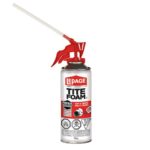Much of a home’s energy can be lost through air infiltration. Air flows through gaps and cracks in various locations around the building structure, meaning that more energy is used to maintain the comfort level of the home. A great solution to this problem is by using an insulating foam sealant, which outperforms other types of insulation because it can expand and tightly fill those crevices that otherwise may have been left exposed.
It is important to choose the right type of spray foam insulation so that air flow is properly deflected, as thermal insulation depends on the structure and size of the cells within the foam’s structure.
LePage TITE FOAM is a high-density foam with a uniform cell structure that delivers premium durability and has superior flexibility that withstands building & material movement. This makes it an ideal choice for filling, sealing and insulating gaps and cracks, inside and out. Worried about reusability? The newly introduced dispensing system offers improved functionality with a special ‘plug’ that seals the dispensing straw so you can re-use the product and leave less of a mess behind.
- It is recommended foam be protected from UV radiation by a protective covering
or coating such as paint, plaster, mortar, etc. - Cured foam can be trimmed, sanded, shaped, painted and stained.




